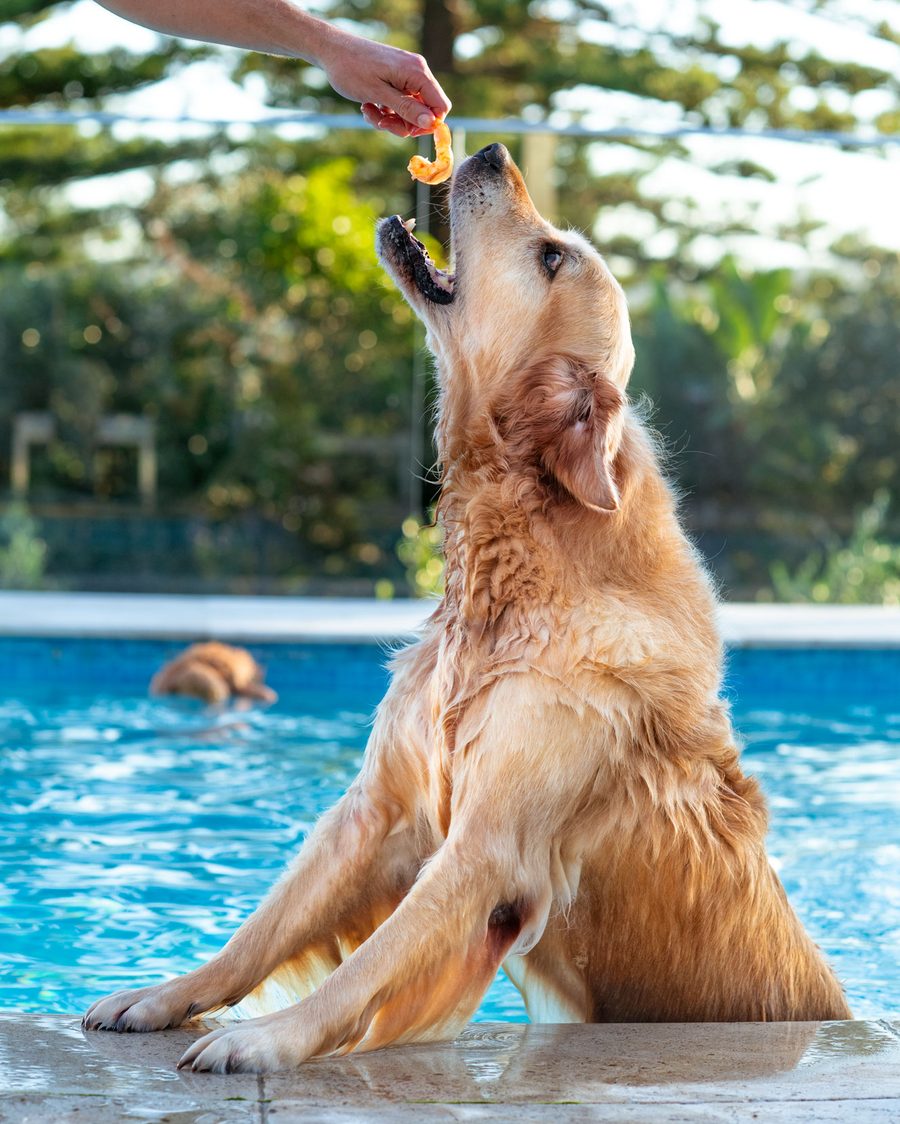Here’s what we put on our seafood platter, a staple on Christmas Day for the RecipeTin Family! Our top tips for what to get, where best to spend your money and where not to, and our favourite seafood sauces. Plus, a video at the Sydney Fish Markets – watch me choose the seafood!

A lifetime of eating seafood!
In today’s recipe, I’m sharing all the items we put on our seafood platter – a staple on Christmas Day! We love the ease (mostly no-cook, just assembling) and because it’s a treat reserved for special occasions. Australian seafood is incredible, but good quality seafood is not cheap!
This is why we are pretty meticulous with research and taste-testing our seafood – we even write nerdy notes to ourselves as reminders, to refine our purchases for the next shop. Because there’s nothing more disappointing than spending hard-earned money on expensive crab only to find it tastes completely bland.
So this post today is essentially our shopping list of what we include on our seafood platter. Learn from all the tips we have picked up over a lifetime of seafood eating, and watch me buy the seafood at the Sydney Fish Markets to put the seafood platter together in today’s video!


THREE RULES WE LIVE BY for tastier seafood*
-
Always buy Australian.
-
The less it’s been frozen, the better.
-
Avoid pre-packaged* (it’s stinky). Buy fresh from open displays.
* There are some exceptions and explanations to this rule, noted against specific items. See Seafood Buying Tips section below for more information!
SUMMARY – What we put on our seafood platter
Here is a summary list of what goes on our seafood platter. Please see below sections on the why, why not, and extra tips. Note: I’m in Sydney, Australia.
1. pre-cooked seafood, served cold

This is the seafood we get that we purchased pre-cooked, or seafood that is served raw. Everything we get is Australian – we specifically ensure it is because we know it will be better.
-
Prawns (pre-cooked) – Tiger, king or banana prawns.
-
Oysters – Pacific or Sydney Rock (Tasmanian and Merimbula oysters are my favourites)
-
Morton Bay Bugs (over Balmain Bugs) – Pre-cooked.
-
Blue swimmer crabs (best over 350g) – Pre-cooked. Alternatively: Spanner crabs, but read crab section below (including king crab & mud crab advice).
-
Sashimi – Kingfish, tuna, salmon are most common
-
Smoked salmon – Sold in packets, I only get Huon (Tasmanian).
-
Dipping sauces – Our Family Favourite Seafood Sauce, and Tartare or Marie Rose sauce (recipes here)
TIPS: Seafood quality is better at fish mongers and the fish markets, one reason being they look after it better than large chain grocery stores. For all the above, we only get Australian, and seafood that’s undergone as little freezing as possible. The freshest seafood has never been frozen: caught and sold ideally on the same day. However the reality is some seafood has to be snap frozen at sea before reaching market and is sold thawed. This includes even cooked prawns at the fish markets during Christmas time. Done properly, excellent seafood quality is still maintained.
But the point is, the less freezing-thawing cycles, the better. The worst is: Caught > frozen > thawed > cooked > frozen > thawed (like cheap lobster at grocery stores likely is). Quality degrades with each step!
2. luxury seafoods – ONLY BUY if you can afford quality

Here are the top-ticket seafood platter signatures that we strongly recommend only buying if you can afford good quality. And by no means will your platter be any less delicious without them! These are not regulars on our seafood platter.
-
Lobster (crayfish) – Not worth it unless you can afford $100+/kg for high quality lobster. The cheap grocery store lobsters are rubbish (sorry, but they are). Lobster serving recipes here.
-
King crab (~$90/kg) – Everybody loves the big meaty crab legs! While they are sold pre-cooked for convenience, we find the pre-cooked product very hit and miss. King crab is imported which can also play a part in the variability of quality. So we stopped buying pre-cooked king crab after too many disappointments for such an expensive food. Want king crab? Best buy raw legs and cook it yourself.
-
Mud crab (~$90/kg) – Buy it live and cook it yourself (here’s how to prepare mud crab). You don’t see often see frozen or cooked mud crab. If buying cooked mud crab, check with the seller how fresh it is and when it was alive (we are suspicious by nature and assume it was half dead so they cooked it).
3. SEAFOOD WE COOK (SOMETIMES)
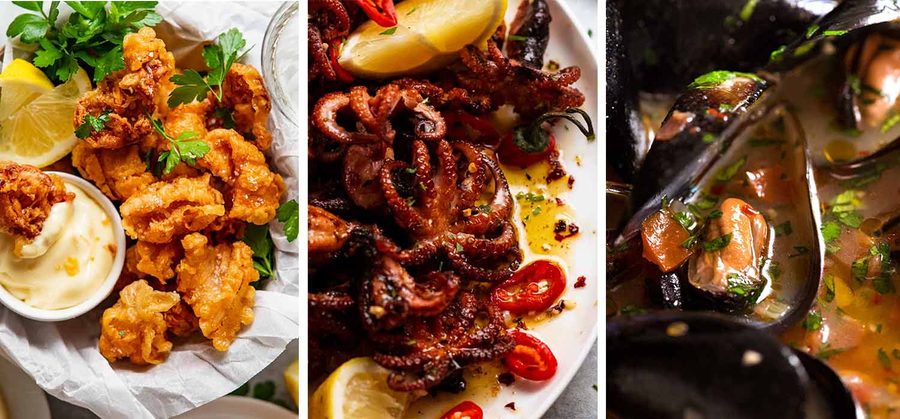
While our seafood platter is mostly comprised of cold pre-cooked seafood, if we do have cooked seafood, these are the dishes we most commonly include.
-
Baby octopus – Purchased in bags frozen or raw, marinated then BBQ’d until the legs are charred and crispy! Rare seafood item that freezes well.
-
Mussels – Cooked ahead and served at room temperature (it’s so great!). Mussels are a rare seafood item that vac packs well. Our favourite brand are Kinkawooka blue mussels (best quality, juiciest!) – look for the purple bag, sold even at regular grocery stores.
-
Salt and pepper squid – 3 years in the making, we finally cracked the perfect salt and pepper squid! This is on the RecipeTin Family Christmas menu for this year. Recipe coming before Christmas…
4. STANDARD SIDES
Here are the standard sides we serve alongside a seafood platter:
-
Good bread (I love using my Crusty Artisan Bread recipe) with good butter or good extra virgin olive oil – Always!
-
Potato salad or macaroni salad – … sometimes
-
A Show-Off Salad like this festive Apple Salad with Candied Walnuts and Cranberries or Pomegranate Salad (more Show-Off Salads here)
And honestly, that’s all we do. We keep it simple to let the seafood shine! Also, because Christmas should be about be relaxing not slaving in the kitchen, is our motto. 🙂


5. GOING THE EXTRA MILE
If we’re feeling particularly inspired or have VIP guests, we will go the extra mile and add “special” extra dishes. Things we reach for include:
-
Christmas Baked Salmon – A big statement side of salmon that’s made for Christmas festivities!
-
Crispy Beer Battered Fish – and I exaggerate not when I say they are crispy and stay crispy!
-
Crispy Homemade Fries – they’re crispy even long after they cool
-
Store bought potato gems (tater tots) – I’m not even going to pretend we attempt to make these. We buy frozen, we love ’em, and I’m not ashamed to tell the world! For special occasions, we even deep fry them instead of baking (OMG I know, you’re horrified).
-
Chinese Honey Prawns – OMG YES!!! Crunchier than you’ve ever had at any Chinese restaurant, these will blow your mind!
-
Singapore Chilli Crab – A big, giant, statement main.
-
Whole Baked Fish – The dill butter sauce is everything….
-
Any other seafood or fish recipe – here’s the full collection.
5. seafood sauces

With the above fresh seafood, we simply serve with fresh lemon wedges and two sauces (recipes here):
-
Family Favourite Seafood Sauce – A family staple. Everybody who’s tried this sauce loves it! It’s essentially a mash up of Marie Rose Sauce and Tartare sauce with the added freshness from dill. It’s a bit special, and always a hit. 🙂
-
Marie Rose / Thousand Island – The classic pink sauce.
-
Cocktail Seafood Sauce – A piquant red sauce that goes heavier on the tomato sauce (ketchup).
-
Tartare Sauce – It’s amazing how much better homemade tastes, even using jar mayo. Yet so simple!
-
Thai Chilli Lime Sauce – Tangy with lime and hit of sweet chilli, for a lovely no-mayo fresh sauce alternative.
Our standard choice is the Family Favourite Seafood Sauce plus either Marie Rose or Tartare.
Find all the Seafood Dipping Sauces here.
More about each seafood item
I warned you I have a lot to say about seafood!! 😂 So in this section, I’m delving into more details about each.
Prawns

Prawns are a dependable favourite in Australia, and we are blessed with an abundance of excellent quality prawns! The 3 most common varieties are:
-
Tiger prawns – More salty and savoury.
-
King prawns – More of a sweet flavour. (You’d expect them to be larger, but they aren’t always!).
-
Banana prawns – Sweet, mild flavour, and often more economical
We love them all, and will happily eat any of them.

TIPS
-
We buy them pre-cooked – Most Australian prawns are cooked soon after being caught, which locks in freshness and flavour. As long as they are fresh, the quality is excellent. You could also buy them raw and boil yourself.
-
Be sure to get Australian prawns because the flavour is superior, the flesh is sweeter, and to support the Australian fishing industry! While most tiger and king prawns are locally sourced, imported banana prawns are more common. Just take note of the display label.
-
Avoid pre-packaged prawns. They can be less fresh and stinky, beware! If that’s all you can get, take them out well before serving, give them a good rinse then leave to air dry.
-
TOP TIP: Ask for a taste test before you buy!
Moreton Bay bugs – the better value lobster
This is one of our gold nugget tips! 🥰


We prefer to eat Moreton Bay bugs instead of lobster. They taste similar to lobster yet are about 70% cheaper at ~$40/kg. In fact, Moreton Bay bugs (and Balmain bugs) are a slipper lobster and are closely related to rock lobsters, so the flavour similarity is not surprising!
Moreton Bay bugs also have a higher meat-to-shell ratio (30-40% yield) than lobster and are easier to cut. They are more compact in shape, so easier to store too. They are caught on the northern part of Australia’s coast, mostly off the coast of Queensland.
We buy them pre-cooked (orange-coloured) which is the most common way they are sold, though you can get them raw (aka “green”, on the right below) and cook yourself (just boil them).

Balmain bugs vs Moreton Bay bugs – Balmain Bugs are the other species of slipper lobsters sold in Australia. We usually buy Moreton Bay over Balmain bugs, as we prefer the milder flavour, find the quality usually more reliable, and they’re also generally larger. Also, just FYI, despite the name, Balmain bugs aren’t actually caught in the Balmain area of Sydney! They are caught across the southern coastline of Australia, though mainly in NSW. But if you can’t find Moreton Bay bugs, Balmain bugs is a solid alternative.
Oysters
Here in Australia, we have two varieties of oysters: Pacific oysters and Sydney Rock oysters. Pacific oysters tend to be larger, with a fleshy, creamy texture. The flavour is clean and mild. Sydney Rock Oysters tend to be smaller, sometimes with yellow-tinged flesh and have a meatier mouthfeel. The flavour is stronger and more complex than Pacific oysters.
I love both of them!

Both these oysters are grown in various areas across Australia, and the region in which they are grown affects quality and flavour. I am particularly fond of Tasmanian-grown oysters (clean flavour without a bitter finish, and some are gigantic!). Merimbula is a Sydney fine-dining favourite source as are Port Stephens and Batemans Bay. Boomer Bay is a recent one I tried that I enjoyed as well.
Buy them already shucked (ie. opened) and serve with lemon wedges, that’s all you need. Though, if you’d like to try a sauce, 3 of our favourites are coming before Christmas!

Crab
I have a bizarre amount of information to share about crab! Possibly because I love crab but it’s expensive – and it’s a pain to pick out the meat especially if you buy certain types. 😂
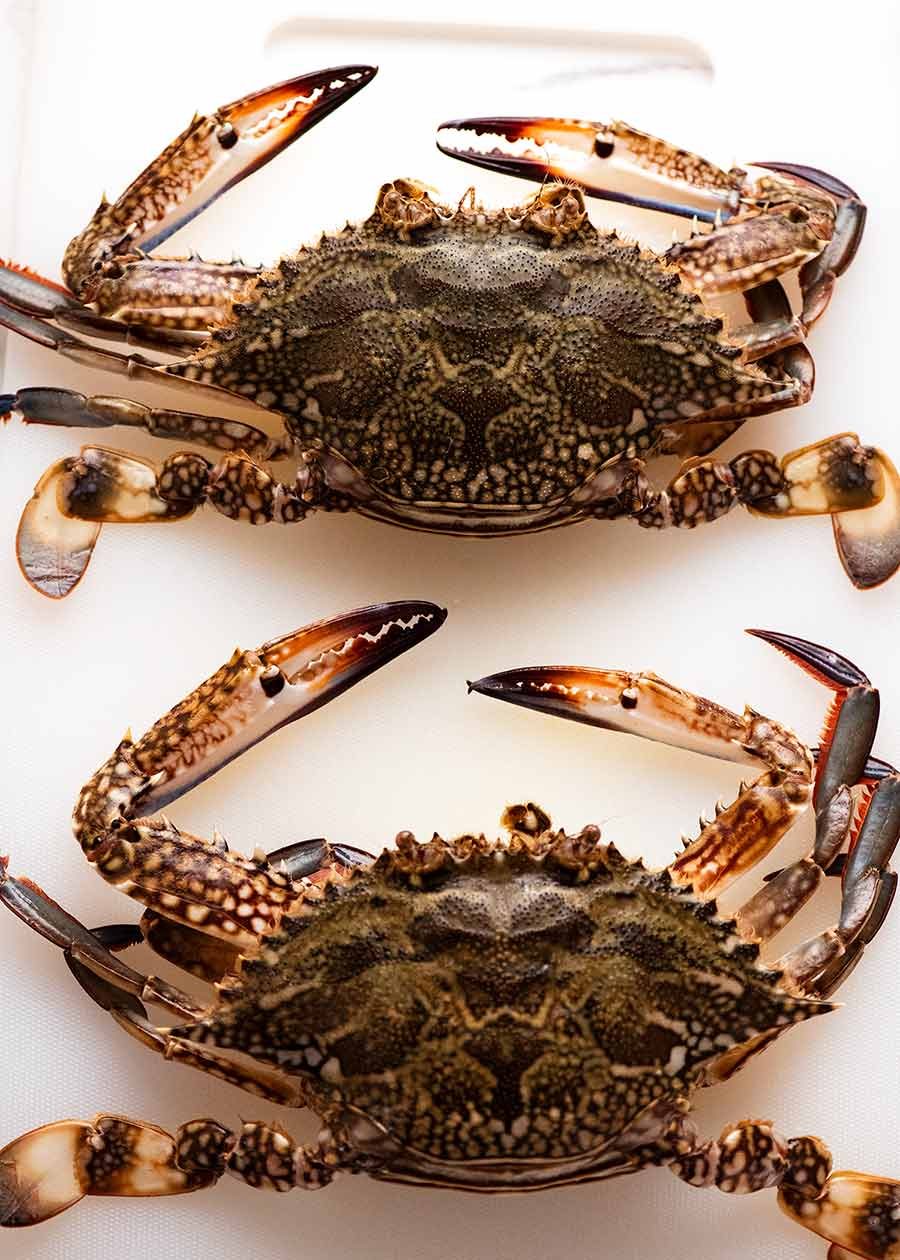
So here’s my thoughts on crab:
-
Blue swimmer crab (~$35/kg) – This Australian favourite is our preference for value, flavour and quality as long as they are on the large size (350g/ 12 oz+). Anything smaller and the ratio of meat-to-shell is too low, and it’s a pain to pick the meat out of tiny legs. Buy it cooked, or buy raw and cook yourself (just boil).
-
Spanner crab (~$35/kg) is also good value but the crab’s anatomy is very different to blue swimmer crabs. The meat is mostly in the body, which is proportionally large while the claws are small and flat. The crab flesh is deliciously sweet. However it is quite fine and more crumbly than other crabs. Buy it cooked. You don’t often see it raw.
-
King crab – People love king crab because of the extremely meaty legs and claws, and the firm, sweet flesh. But it’s expensive! We recommend giving frozen cooked king crab a miss. Over the years, we’ve found it hit and miss, as it’s sometimes disappointingly flavourless – such a waste of money 😭. If you want king crab, buy the uncooked legs and cook yourself. Note that king crab is mostly imported and as a general rule, this can affect reliability of quality. Excess freezing really seems to degrade the quality of crab.
-
Mud crab – The king of all Aussie crabs! We love it (especially Singapore Chilli Crab), but as it is sold live it is quite expensive and you have to cook it yourself. You rarely see it frozen or pre-cooked. When we do, we are suspicious as it’s hard to know how fresh the crab was prior to cooking.
Cutting crab for serving – directions in the recipe card! There’s even a video. 🙂



Sashimi (raw fish)
Yes, we do! Totally at home on a seafood platter 🙂

There’s no need to get loads, just a little bit, for extra variety in the platter amongst all that shellfish. We just go to the sashimi bar at the Sydney Fish Markets and get what looks good or what we feel like. Kingfish, tuna and salmon are favourites, but we love to mix it up if there are other interesting fish varieties on offer.
Smoked salmon
A nice easy one to include on the seafood platter. Everybody loves it, and again, it adds to variety and abundance!
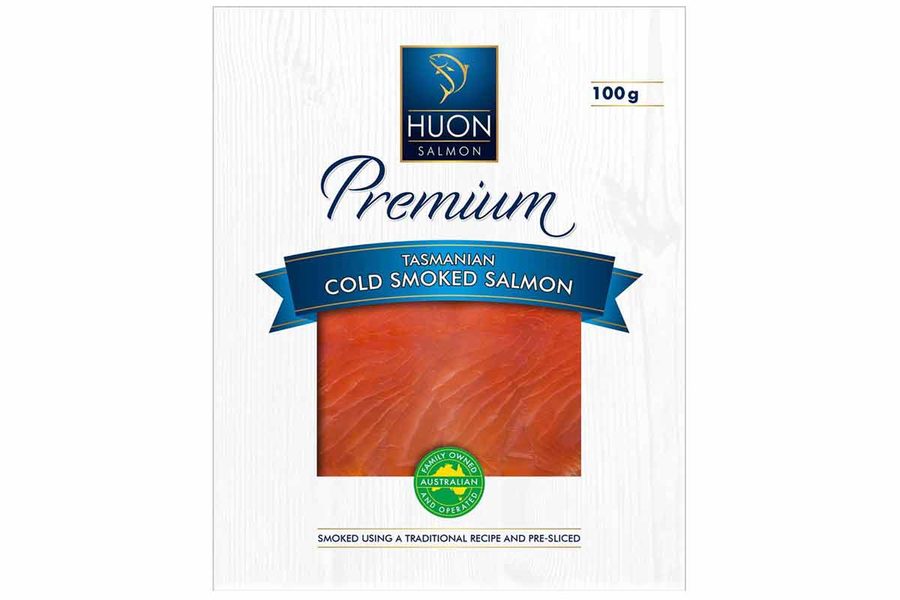
The only smoked salmon I get is Huon Salmon. I know there’s a lot of debate about the sustainability of salmon farming here in Australia. However based on my research (and also a visit to their farms in Tasmania), I believe Huon’s farming practices to be more sustainable than the other major brand here in Australia and imported economical brands, and kinder to local wildlife.
Cooked mussels
A recent addition to our cold seafood platter: cooked mussels served at room temperature. It’s so good! They present nicely if you dice up the vegetables really small so you can scatter them on the mussels for presentation purposes. Serve them in the half shell, spooning some mussel cooking liquor sauce into the shells to keep them moist and add some lovely extra flavour.
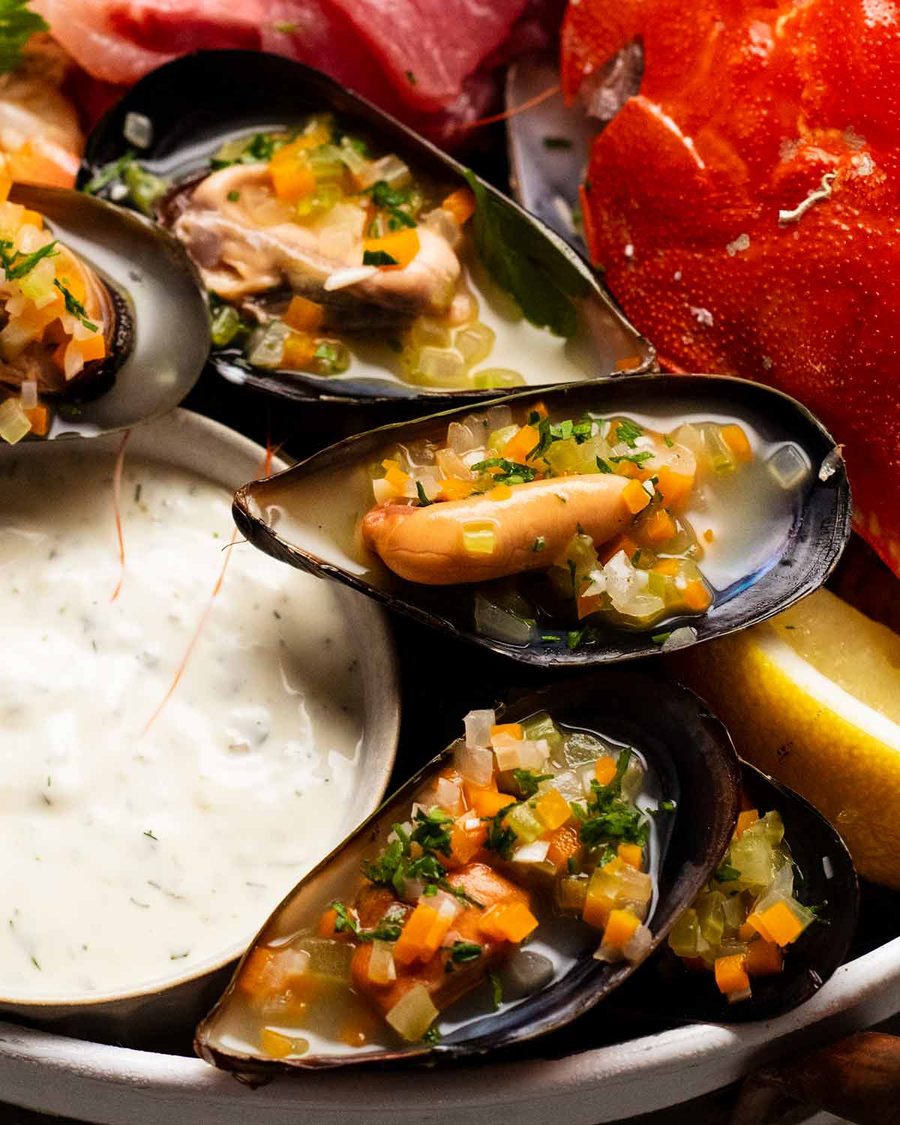
The mussels pictured above were cooked using this cookbook recipe but this recipe will also work (similar). Just remember to dice up the vegetables extra small for an elegant look, like pictured above.
Our favourite brand of mussels is Kinkawooka which are available at grocery stores as well as fish mongers. Compared to other brands, the mussels are considerably heavier which means they are meatier and juicier.

Lobster (actually, crayfish)
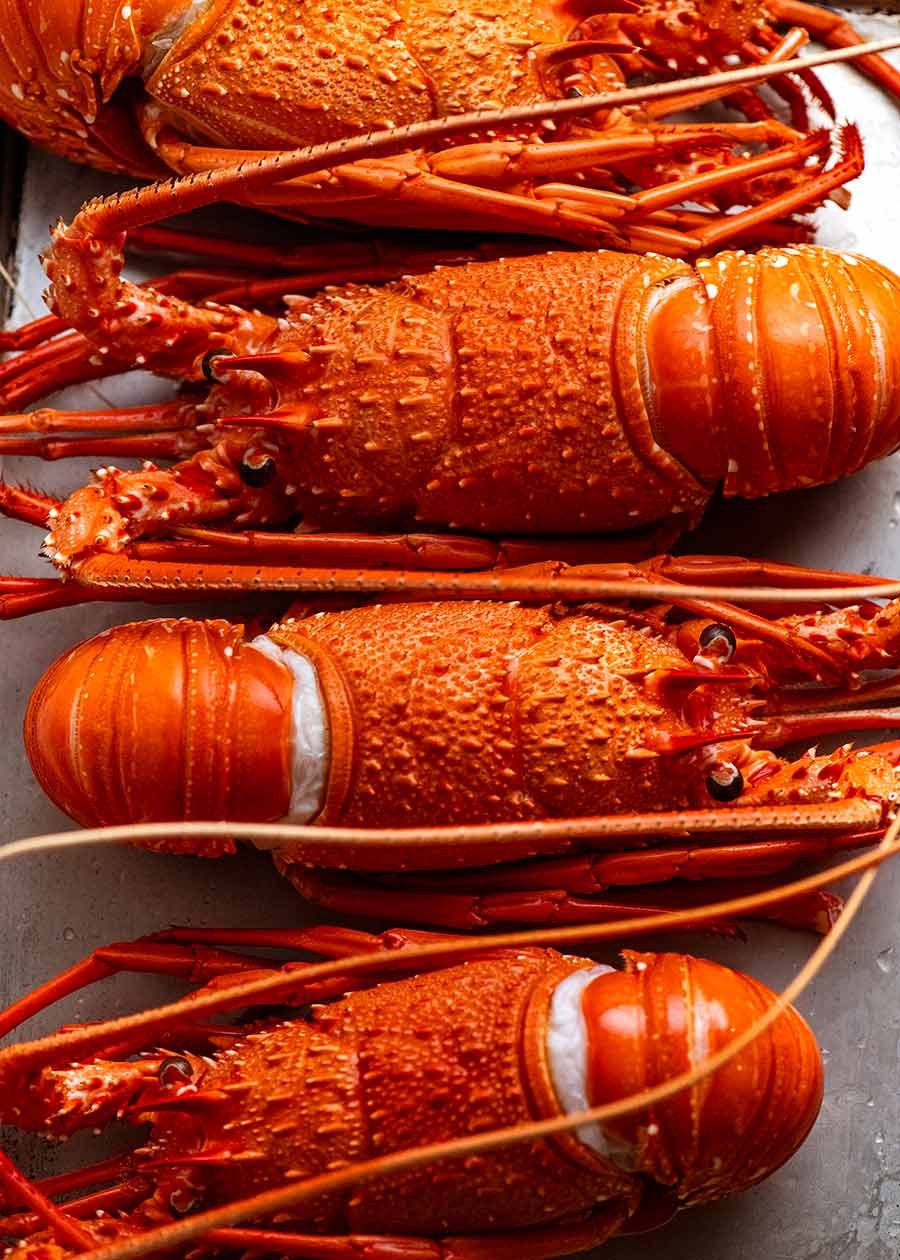
So, here’s the thing with lobster. It is not a regular on our seafood platters. As noted above, we usually get Moreton Bay bugs instead because it’s so similar but far better value and logistically easier to cut, store etc.
However, I do have knowledge to impart about lobster because I have a friend who catches local lobsters and shares them with me. Also, there was that time during the pandemic when our lobster export industry came to a standstill due to trade tensions with China, so there was an abundance of lobsters usually sold upwards of $100 at fish mongers going for $20 at regular grocery stores.
So I’ve actually developed a fair amount of experience cooking with lobster without shelling out an extortionate amount to buy them!

Buying lobster
If you want lobster on your seafood platter, just to reiterate what I’ve said multiple times earlier, be prepared to pay top dollar for it – $100/kg+. There is honestly no point buying the cheap ones (~$10 tails) at grocery stores, they taste like nothing! You are better off using that budget for more prawns.
Choose Australian lobster – cooked is great (it’s boiled freshly caught at sea). Then head over to my lobster recipes to choose one! There are 6 lobster recipes, all of which are suited for inclusion in a seafood platter, along with how to cut and prepare lobster.

PS It’s crayfish, not lobster
And just for a bit of food trivia: What most people call “lobster” here in Australia technically are not lobsters, they are crayfish. They are almost the same in appearance, but they don’t have the giant pincers that lobsters have in the US and Europe. We don’t have true lobsters here in Australia. 😊
TOP TIPS FOR BUYING & storing SEAFOOD
Here are some tips for buying seafood. The overarching principle to remember is that seafood is highly perishable, so needs to be handled properly to maintain quality. Most seafood loses quality (texture especially but also flavour) when not frozen properly or frozen-then-thawed excessively.
-
Buy Australian. It might not be the cheapest, but it’s tastier. Why? The quality of our fisheries and processors, and proximity to the consumer means a fresher product.
-
Buy fresh rather than frozen. Every time seafood is frozen, quality is lost (flavour, texture). Though, there are a few exceptions, like baby octopus, noted in the sections above.
-
Pre-cooked seafood is excellent – and that’s what we mostly buy (prawns, crab, Morton bay bugs). It’s boiled at sea soon after being caught to lock in freshness and flavour!
-
Don’t stretch your budget and get swept up in the “must have lobster” frenzy – unless you can afford the good stuff. Cheap lobster tastes of nothing – been there, done that!! Instead, buy more prawns. 🙂
-
Buy from fresh seafood displays rather than pre-packaged. It’s just fresher and better when seafood can breathe and is on display for shoppers to see. Pre-packaged seafood (vacuum sealed or in containers with cling wrap) gets stinky and who knows how long it’s been in the pack. I particularly avoid vacuum-sealed seafood with a shelf life of weeks. That’s just plain wrong!
-
The sniff test – It’s easy to tell if your seafood is fresh: just smell it. Fresh seafood smells like the ocean. Not very fresh seafood smells unpleasant and “fishy”! Before tossing it though, give it a good rinse. Sometimes, the “off” smell can just be the juices from poorly packaged or handled seafood. This is why I prefer buying seafood from open displays rather than pre-packaged.
-
Never re-freeze seafood that’s been previously frozen. You can cook thawed raw seafood, then freeze it. But should never thaw raw or cooked seafood bought frozen, then freeze it again. (The exception is seafood that may have been industrially frozen at sea – see earlier explanations).
-
Avoid storing seafood in plastic bags where possible – To keep seafood fresh longer, don’t store in plastic bags – especially if overnight or longer. Moisture and lack of air circulation accelerate the spoiling process. Move your seafood to a roomy container or deep plate with a rack at the bottom so air can circulate around it. Wrap loosely with cling film. The seafood stays fresher longer and avoids that awful sliminess and fishy smell that builds up if left suffocating in fish juice in a plastic bag!
Why we buy pre-cooked seafood

Our seafood platter is predominantly cold seafood that we purchased already cooked. The reason for this is simple – the quality of pre-cooked seafood here in Australia is excellent (if you know what to buy) and it’s convenient.
If you’re thinking – surely raw seafood I cook myself is going to be better – it can be true, but it’s often pricier and extra work to prepare!
Actually, pre-cooked seafood can be some of the best tasting seafood you buy because it’s boiled at sea as soon as it is caught, locking in fresh flavour when it is at its prime. Prawns are a great example of this, with most prawns sold at fish mongers here in Australia sold pre-cooked.
Pre-cooking also deals with the logistical challenge associated with how highly perishable seafood is because it extends the shelf life, as well as making the seafood more affordable for consumers.
Where I buy seafood
For special occasions, I go to the Sydney Fish Markets where you get better selection and more consistently higher quality. But on a day to day basis, I just go to my local fish monger.

I generally do not buy seafood from the grocery store, just because I find the quality is not that great and is not always handled with the care it should be.
I do think though that here in Australia, we are very lucky to have an abundance of good quality seafood, so even seafood from grocery stores is actually not that bad. I’m just a bit fussy – I’d rather indulge in seafood less often and spend a little more to get good quality seafood when I do. That’s just the way I roll. 🙂
How we put together the seafood platter
And with all that information and opinions shared, we finally arrive at the serving and eating part!

For the RecipeTin Family, one of the things that appeals to us about a seafood platter is that it’s essentially no-cook, and it’s a cold main which is ideal for hot summer Aussie Christmases. So you literally pull it out of the fridge, pile it up onto platters then serve!
OK, OK. I can give a little more guidance here, in case you’re interested. Here we go:
-
Ice bed – If we have ice, we will spread that onto a big serving platter, tray or multiple plates. This not only keeps the seafood cold, but also provides a nice non-slip bed to put the seafood on.
-
Assembling – Pile the seafood on the ice, randomly scatter lemon wedges around then nestle in bowls of sauces. A few sprigs of parsley might also make it onto the platter – but that’s really going above and beyond. 😂
Laying out the seafood
There’s no rules for the way I lay out the seafood, except logistical considerations:
-
Oysters laid out mostly in a single layer or carefully shingled to avoid the oyster juices from spilling
-
Mussels laid out the same as oysters so the sauce stays in without spilling
-
Prawns, Moreton Bay bugs and crab – piled high (reserve the crab carapace (top shell) for decoration)
-
Sashimi – fanned out
-
Smoked salmon – randomly draped around

Matters of serving (tip: finger bowls!)
To serve, we put the platters out along with plenty of napkins, bowls for discarded shells and finger bowls of water with lemon slices for people to dip their hands in for a brief clean before diving back in for more seafood.


How else can I help you?
And with that, I think I am done! Or – am I? Are there any critical things I’ve missed? Is there other seafood you’d like to know about? Such as, let’s say, abalone. A highly prized delicacy here in Australia – why doesn’t it make our cut, you may be wondering??
This and any other questions you have, please leave them below and we will do our best to address them and update this post with extra information. I can’t promise I will continue to do this beyond Christmas 2023, but I can promise that we will monitor questions and update this post leading up to Christmas Day. Because the whole purpose of doing today’s post is to help readers who want to put together an amazing seafood platter!
I hope you find this useful and enjoy the little video of my shopping trip to the Sydney Fish Markets to choose and purchase seafood for the seafood platter featured in this post. – Nagi x
Watch how to make it
Video of me choosing seafood at the Sydney Fish Markets and putting a seafood platter together:
Also, a little tutorial on how to cut and prepare Moreton Bay Bugs and Balmain Bugs for your seafood platter:
Hungry for more? Subscribe to my newsletter and follow along on Facebook, Pinterest and Instagram for all of the latest updates.

Seafood Platter
#wprm-recipe-rating-0 .wprm-rating-star.wprm-rating-star-full svg * { fill: #343434; }#wprm-recipe-rating-0 .wprm-rating-star.wprm-rating-star-33 svg * { fill: url(#wprm-recipe-rating-0-33); }#wprm-recipe-rating-0 .wprm-rating-star.wprm-rating-star-50 svg * { fill: url(#wprm-recipe-rating-0-50); }#wprm-recipe-rating-0 .wprm-rating-star.wprm-rating-star-66 svg * { fill: url(#wprm-recipe-rating-0-66); }linearGradient#wprm-recipe-rating-0-33 stop { stop-color: #343434; }linearGradient#wprm-recipe-rating-0-50 stop { stop-color: #343434; }linearGradient#wprm-recipe-rating-0-66 stop { stop-color: #343434; }
Ingredients
- 2 kg / 3 lbwhole prawns, pre-cooked, shell on (Tiger, King or Banana prawns)
- 24oysters – Sydney Rock or Pacific, love both (Tasmanian, Merimbula and Port Stephens are favourites)
- 4blue swimmer crabs (400g/14oz+)(not smaller), pre-cooked in shell, whole
- 8Moreton Bay bugs, pre-cooked in shell, whole (fallback – Balmain Bugs)
- 200g / 7 ozsmoked salmon(Huon is the only Australian one I get)
- 250g / 8 ozsashimi, pre-sliced (tuna, kingfish or salmon)
- 1 kg / 2 lbmussels– cooked, served at room temp (Note 5)
Seafood Sauces (choose 2) – all recipes here:
- Cocktail Seafood Sauce
- Tartare Sauce
- Marie Rose / Thousand Island(top pick)
- Thai Chilli Lime Sauce
- RecipeTin Family Favourite Seafood Sauce(top pick)
Other sauces:
- Sauces for oysters(selection coming next week)
- Soy sauce and wasabi, for sashimi
Serving:
- Ice, optional (crushed if you can, else normal)
- Lemon wedges(lots!)
- Parsley sprigs(for decorating, if you’re feeling fancy)
- Bowls, to discard shells
- Finger bowls, filled with water and lemon slices
- Napkins(lots!)
Our standard side dishes
- Good bread with good butter or good extra virgin olive oil (Try this easy Crusty Artisan Bread)
- Perky green salad or vegetable sticks(crudites), see in post for suggestions
- Lots of cold beer, wine and champagne!
Extra dishes pictured in post and the video
- Marinated crispy baby octoptus
- The crispiest salt and pepper squid(recipe coming soon!)
- Cheese and crackers(because I just have to!)
- More extras –see notes
Instructions
-
Purchase all seafood as close as possible to the serving date. We often do the 5AM shop at the Sydney Fish Markets on Christmas Eve, because we are slightly crazy! We don’t order online (we like to choose our own).
-
Storage – Cooked seafood will easily keep 2 days, fresh raw for cooking will too if you take it out of the plastic bags, put in a colander or similar and very loosely cover with cling wrap (breathing = less stinky).
-
Crab – To cut the crab, follow directions in How to Cut a Whole Crab except DO NOT cut off the claws if you are using a Blue Swimmer Crab. (See note)
-
Moreton Bay bug – To cut the bug, flip it on to its back. Cut down through the middle (the shell is not too hard). Clean out the yellow and brown matter in the head, then it’s ready to serve. Recipe video above.
-
Sauce – Make your sauces of choice. They will be used for dipping prawns, Moreton Bay bugs and crab (I also use for vegetable sticks and bread!). Refrigerate until required (2 days+).
-
Mussels – Make mussels, if using. Great served at room temperature on a cold seafood platter.
Assembling:
-
Ice (optional) – Cover a large platter with ice. This keeps the seafood cold as well as providing a non-slip bed.
-
Pile the prawns, crab and bugs on to the platter. Drape smoked salmon randomly around. Fan out the sushi.
-
Oysters –Place them level to avoid the juices in the shells spilling out (what a waste!).
-
Mussels –Break off one shell, and serve in the remaining shell. Then place the mussels in a single layer, or shingled (stacked but level). Spoon on a little of the diced vegetables and some reserved mussel cooking liquor.
-
Sauce and lemon – Nestle bowls filled with sauces amongst the seafood and scatter over lemon wedges. Serve alongside finger bowls for cleaning and bowls to discard shells, and lots of napkins. Fill glasses with wine, cheers to Christmas! Now dive in!
Recipe Notes:
See in post for more tips and thoughts on each item listed. Summary points below!
- Prawns – Tiger, king and banana prawns in Australia are all great, though if I had to pick one I’d choose tiger prawns (I love the salty slightly more intense flavour). Watch out for imported – Australian prawns are superior in flavour.
- Oyster – Both Sydney Rock (smaller, stronger flavour) and Pacific (fleshier, cleaner flavour) oysters are great. These are the two varieties here in Australia. The quality and flavour comes down to where and how they are grown.
- Moreton Bay bugs – The “better value lobster”!. At ~$40/kg, they’re easier to cut, to eat and have a higher meat-to-shell ratio. There’s really no point getting cheap lobster, tastes of nothing. If you get lobster, you need to spend $100/kg+. Don’t bother with cheap lobster!
- Crab – Blue swimmer crabs for the best for flavour (in our view) and value, but don’t get small ones <350g/12oz, it’s a pain to get the meat out. Spanner crab is also great but all the meat is in the shell (cut per same directions). Mud crab and king crab – please read in post for our view on these (buy raw, make sure it’s Australian, and cook yourself), they are expensive so get it right!
- Mussels – cooked using this cookbook recipe or this recipe, but dice the vegetables very small (to use as garnish on mussels). Cool to room temperature then serve on platter.
Life of Dozer
One of my favourite photos of Dozer in the cookbook. Buried smack bang in the middle of the book, it must be quite a shock for people who don’t know me to be flicking through tasty food photos then suddenly come across this!! 😂 (Page 174, Restaurant Worthy Prawn Linguine).
